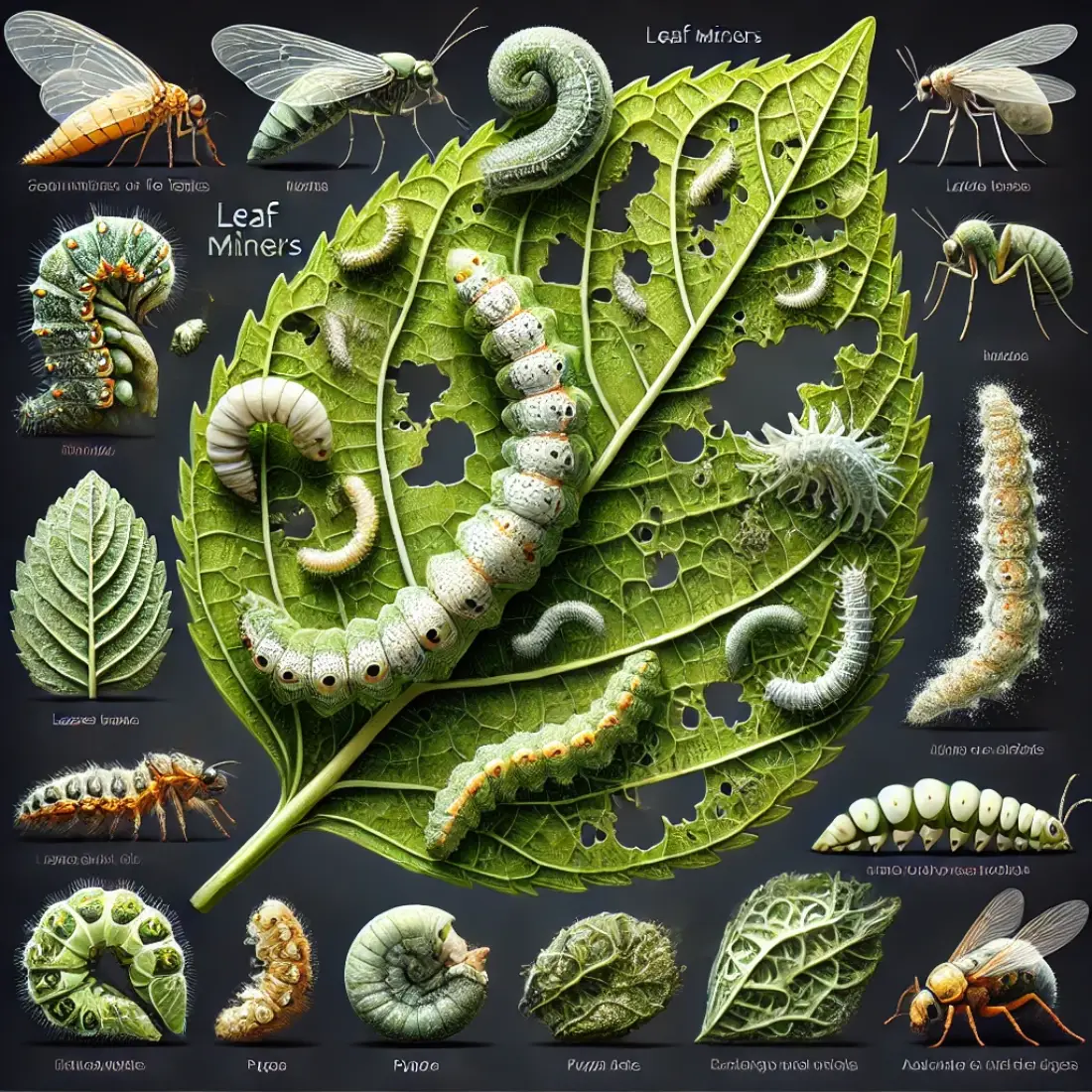Leaf miners are a common pest that can cause significant damage to a variety of plants. These tiny insects burrow into leaves, creating unsightly trails and weakening the plants by feeding on their internal tissues. Leaf miners can affect a wide range of plants, including vegetables, ornamentals, and fruit trees, making them a concern for both home gardeners and commercial growers.
Controlling leaf miners is essential not only for maintaining the aesthetic value of your garden but also for ensuring the health and productivity of your plants. While chemical pesticides are available for managing these pests, they often pose risks to the environment, beneficial insects, and human health. Therefore, organic methods of control are increasingly preferred for their safety and sustainability.
Information About Leaf Miners
Leaf miners are a group of insect larvae that feed within the leaves of various plants, creating distinctive tunnel-like patterns or blotches. They can belong to different insect families, including moths, flies, beetles, and sawflies.
Appearance and Identification
- Larvae: Leaf miner larvae are usually small, legless, and can be various colors ranging from white to yellow to green.
- Damage Signs: The most recognizable sign of leaf miner activity is the serpentine or blotchy trails they leave as they consume the internal leaf tissues. These trails can appear white or translucent and often expand as the larvae grow.
Life Cycle
- Eggs: Adult leaf miners lay their eggs on or inside the leaves of host plants.
- Larvae: Once hatched, the larvae burrow into the leaf and start feeding, creating tunnels.
- Pupae: After completing their larval stage, they exit the leaf to pupate in the soil or within the leaf itself.
- Adults: The cycle completes when adults emerge, ready to mate and lay eggs.
Common Host Plants
Leaf miners can infest a wide range of plants, including:
- Vegetables: Spinach, tomatoes, peas, and lettuce.
- Ornamentals: Birch, boxwood, columbine, and azalea.
- Fruit Trees: Citrus, apple, and pear trees.
Impact on Plants
- Aesthetic Damage: The tunneling leaves unsightly marks on leaves, reducing the visual appeal of ornamental plants.
- Reduced Vigor: Heavy infestations can weaken plants, as damaged leaves are less efficient at photosynthesis.
- Secondary Infections: The damaged areas can become entry points for pathogens and other pests.
Natural Control Methods
Homemade Sprays
Homemade sprays are an effective, natural way to control leaf miners without resorting to chemical pesticides. These DIY solutions can deter or kill pests while being safe for the environment, humans, and beneficial insects.
Garlic Spray:
- Ingredients: 2 bulbs of garlic, 1 quart of water, 1 teaspoon of liquid soap.
- Preparation: Blend garlic with water, strain the mixture, and add liquid soap.
- Application: Spray on affected plants, covering both tops and undersides of leaves. Reapply every 7-10 days or after rain.
Chili Spray:
- Ingredients: 10-12 fresh chili peppers or 1 tablespoon of chili powder, 1 quart of water, 1 teaspoon of liquid soap.
- Preparation: Blend chili peppers with water, strain, and add liquid soap.
- Application: Spray on plants, focusing on infested areas. Reapply every 7-10 days or after rain.
Preparation and Application
- Mixing: Ensure all ingredients are thoroughly mixed for even distribution.
- Straining: Use a fine mesh strainer to remove solids that could clog the spray bottle.
- Application Timing: Apply in the early morning or late afternoon to avoid leaf burn and maximize effectiveness.
Effectiveness: Garlic and chili sprays deter leaf miners by making the plants unappealing and disrupting their feeding.
Reapplication: Spray every 7-10 days or after heavy rainfall to maintain protection.
Remove Affected Leaves
One of the simplest and most immediate methods to control leaf miners is to remove the affected leaves from your plants. This strategy helps to reduce the population of leaf miners and prevents further damage.
Regular Inspection of Plants
- Frequency: Regularly inspect your plants, ideally on a weekly basis, to catch leaf miner infestations early.
- Timing: Early morning or late afternoon is the best time for inspections as the light is ideal for spotting damage.
Identification of Leaf Miner Damage
- Visual Cues: Look for winding, white or translucent trails on the leaves, which indicate the presence of leaf miners.
- Affected Plants: Pay particular attention to plants that are commonly targeted by leaf miners, such as spinach, tomatoes, and various ornamentals.
- Severity: Assess the severity of the infestation. Minor damage might not warrant leaf removal, especially if the plant is otherwise healthy.
Removal and Destruction of Affected Leaves
- Safe Removal: Using clean, sharp scissors or pruning shears, carefully cut off the affected leaves. Avoid tearing or damaging the plant further.
- Disposal: Do not compost the removed leaves, as this can allow the leaf miners to continue their life cycle. Instead, dispose of them in a sealed bag and place it in the trash.
- Continuous Monitoring: After removing the affected leaves, continue to monitor the plants regularly for any new signs of leaf miner activity.
Benefits
- Immediate Reduction: Removing affected leaves provides an immediate reduction in the leaf miner population, limiting further spread.
- Prevention of Reinfestation: By destroying the larvae within the leaves, you prevent them from maturing into adults that can lay more eggs.
- Healthier Plants: Regularly removing damaged leaves can help maintain the overall health and appearance of your plants, promoting better growth and yield.
Neem Oil
Neem oil is a highly effective organic solution for controlling leaf miners. Extracted from the seeds of the neem tree (Azadirachta indica), this natural insecticide disrupts the life cycle of pests without harming beneficial insects, humans, or the environment.
Derived from the seeds of the neem tree, neem oil has been used for centuries in traditional agriculture and medicine.
Active Ingredient: The primary active compound in neem oil is azadirachtin, which interferes with the feeding, growth, and reproduction of insects.
Mechanism of Action Against Leaf Miners
- Disruption of Life Cycle: Neem oil disrupts the hormonal balance of insects, preventing larvae from maturing and adults from laying eggs.
- Feeding Deterrent: It acts as an antifeedant, reducing the damage caused by leaf miners as they stop feeding on treated plants.
- Growth Inhibitor: It inhibits the development of larvae into mature insects, reducing the overall pest population.
Application Methods and Frequency
Concentration: Use a neem oil concentrate diluted according to the manufacturer’s instructions, typically around 1-2 tablespoons per gallon of water.
Mixing: Mix the solution thoroughly in a spray bottle or garden sprayer. Adding a few drops of mild liquid soap can help emulsify the oil, ensuring even distribution.
Application
- Timing: Apply neem oil in the early morning or late afternoon to avoid the hottest part of the day and prevent leaf burn.
- Coverage: Thoroughly spray the affected plants, covering both the tops and undersides of the leaves where leaf miners tend to lay eggs.
- Frequency: Reapply neem oil every 7-14 days, or as needed, based on the severity of the infestation and weather conditions.
Precautions
- Avoid Application During Bloom: While neem oil is generally safe for bees, it’s best to avoid spraying it directly on flowers to minimize any potential impact on pollinators.
- Weather Considerations: Avoid applying neem oil just before rain, as it can wash off the treatment, reducing its effectiveness.
Benefits
- Environmentally Friendly: Neem oil is biodegradable and breaks down quickly in the environment, making it a sustainable choice for pest control.
- Safety: It is non-toxic to humans, pets, and beneficial insects when used as directed.
- Versatility: In addition to controlling leaf miners, neem oil is effective against a wide range of other garden pests, such as aphids, whiteflies, and spider mites.
Row Covers
Row covers are an effective and environmentally friendly method to protect plants from leaf miners and other pests. These physical barriers prevent adult insects from laying eggs on the plants, thereby disrupting the life cycle of leaf miners.
- Protection: Row covers act as a barrier to prevent insects, including leaf miners, from accessing the plants and laying eggs.
- Microclimate: They also create a favorable microclimate by retaining moisture and warmth, promoting healthy plant growth.
Types of Row Covers Available
- Floating Row Covers: Made from lightweight, breathable fabric, these covers are placed directly over the plants and are not anchored to the ground. They “float” over the crops as they grow.
- Supported Row Covers: These covers are draped over hoops or frames to create a tunnel-like structure, providing more space for plant growth and easier access for gardeners.
Proper Usage to Protect Plants
Installation:
- Timing: Install row covers early in the growing season before leaf miners become active. This prevents adult insects from reaching the plants to lay eggs.
- Anchoring: Secure the edges of the row covers with soil, rocks, or stakes to prevent insects from entering from the sides or underneath.
Monitoring and Maintenance:
- Regular Checks: Inspect the row covers regularly for any signs of damage or gaps that could allow insects to enter.
- Weeding: Keep the area under and around the row covers weed-free, as weeds can harbor pests.
- Ventilation: In hot weather, lift the covers periodically to allow air circulation and prevent overheating of the plants.
Removal and Reapplication:
- Growth Stages: Remove or adjust the row covers as plants grow and begin to flower, especially for plants that require pollination. You can remove covers once the threat of leaf miners has passed, typically when adult activity decreases.
- Reapplication: Reapply covers if new signs of leaf miner activity are detected or if there is a risk of reinfestation.
Benefits
- Non-Chemical Control: Row covers provide a physical barrier against pests without the use of chemicals, making them safe for organic gardening.
- Multiple Uses: In addition to pest control, row covers can protect plants from frost, wind, and intense sun, extending the growing season.
- Cost-Effective: Row covers are reusable and relatively inexpensive, providing long-term protection with proper care and storage.
Sticky Traps
Sticky traps are a simple, non-toxic method to manage leaf miner populations and other flying insect pests in your garden. These traps attract and capture adult insects, preventing them from laying eggs on your plants.
- Attraction: Sticky traps are typically coated with a sticky adhesive and colored bright yellow or blue, which attracts many types of flying insects, including leaf miners.
- Capture: Once the insects land on the trap, they become stuck to the adhesive and cannot escape, thereby reducing the population of adult pests.
Placement:
- Proximity to Plants: Place sticky traps near or above the affected plants to capture leaf miners and other pests. Ensure they are positioned close enough to attract the insects but not in direct contact with the plants.
- Height: Position the traps at the height of the plant canopy or slightly above to maximize their effectiveness in attracting adult leaf miners.
- Distribution: Use multiple traps spaced evenly throughout the garden or greenhouse to cover a larger area and increase the likelihood of capturing pests.
Maintenance
- Regular Monitoring: Check the traps regularly, at least once a week, to monitor pest populations and replace traps when they become full of insects or dirty.
- Replacement: Replace the traps as needed, typically every 4-6 weeks or when the adhesive is no longer effective.
- Protection from Elements: To extend the life of the traps, place them in areas sheltered from heavy rain and strong winds, which can reduce their stickiness and effectiveness.
Benefits
- Non-Toxic: Sticky traps do not involve chemicals, making them safe for organic gardening, pets, and beneficial insects that are not attracted to the traps.
- Monitoring Tool: They help gardeners monitor pest populations and identify the types of pests present, allowing for more targeted pest management strategies.
- Cost-Effective: Sticky traps are inexpensive and easy to use, providing an affordable pest control option.
Limitations
- Specificity: Sticky traps primarily target flying adult insects and may not be effective against larval stages or non-flying pests.
- Visual Impact: The bright color and presence of trapped insects may be visually unappealing in a garden setting.
- Maintenance: Regular maintenance is required to ensure traps remain effective and to prevent buildup of debris or non-target insects.
Steps to Use Sticky Traps
Select Appropriate Traps: Choose yellow or blue sticky traps designed for garden use. Yellow traps are more effective for leaf miners.
Install Traps: Hang or stake the traps at the recommended height, ensuring good coverage of the affected area.
Monitor and Maintain: Regularly check and replace the traps to maintain their effectiveness.
Analyze Captured Insects: Use the traps as a monitoring tool to understand pest populations and adjust other control measures accordingly.
Companion Planting
Companion planting uses certain plants to enhance growth, repel pests, and improve garden health, effectively managing leaf miners.
Mutual Benefits: Enhances growth, pest control, and overall garden health.
Pest Deterrence: Uses plants that repel or distract pests naturally.
Specific Companion Plants
- Marigolds: Repel leaf miners with their strong scent.
- Basil: Deters pests and enhances neighboring plant flavors.
- Nasturtiums: Attract leaf miners away from valuable crops.
- Lavender: Deters pests with strong fragrance.
- Chives and Garlic: Repel pests and improve plant health.
FAQs on Organic Leaf Miner Control
What are leaf miners and why are they a problem?
Leaf miners are the larvae of various insects that burrow into leaves and feed on their internal tissues, creating unsightly trails and weakening plants. They can reduce plant vigor and yield, making them a significant concern for gardeners.
How can I identify leaf miner damage on my plants?
Look for winding, white or translucent trails on the leaves. These trails are the feeding paths of the larvae and are often accompanied by patches of discolored or dead tissue.
Is removing affected leaves an effective method to control leaf miners?
Yes, regularly inspecting and removing affected leaves can reduce leaf miner populations by eliminating larvae before they mature and spread.
What beneficial insects can help control leaf miners?
Parasitic wasps, such as Diglyphus isaea, are natural predators of leaf miners. They lay their eggs inside the leaf miner larvae, which then get consumed by the wasp larvae.
How do I use neem oil to control leaf miners?
Mix neem oil according to the manufacturer’s instructions and spray it on affected plants, ensuring coverage of both the tops and undersides of leaves. Reapply every 7-14 days or after rain.
What is spinosad and how does it work against leaf miners?
Spinosad is an organic insecticide derived from soil bacteria. It targets the nervous system of insects, causing paralysis and death. Apply it to affected plants, following the manufacturer’s instructions.
How can row covers help prevent leaf miner infestations?
Row covers act as a physical barrier that prevents adult leaf miners from reaching the plants to lay eggs. Install them early in the growing season and secure them well to ensure no gaps.
Are sticky traps effective against leaf miners?
Yes, sticky traps attract and capture adult leaf miners, reducing the number of eggs laid on plants. Place them near affected plants at the height of the plant canopy.
What are some effective companion plants for controlling leaf miners?
Marigolds, basil, nasturtiums, lavender, and garlic can repel leaf miners or attract beneficial insects that prey on them. Plant these among or around susceptible crops.
How can homemade sprays help control leaf miners, and how do I make them?
Homemade garlic and chili sprays deter leaf miners by making plants unappealing. Blend garlic or chili with water, strain, and add liquid soap. Spray on plants every 7-10 days or after rain.














